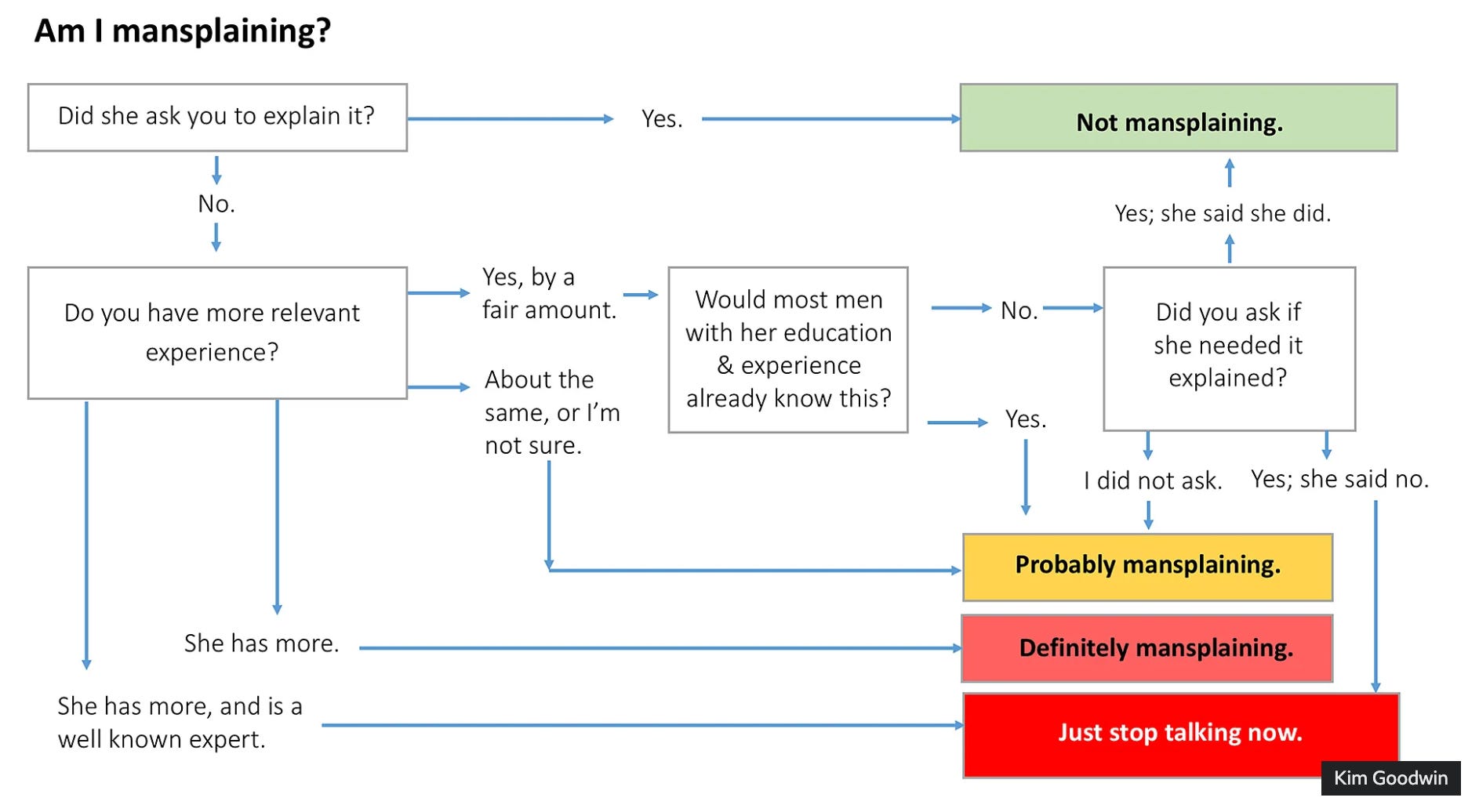“Was That Mansplaining?” A Field Guide for the Well-Intentioned
A conversation (not a call out!) on what mansplaining is, what it isn’t, and why it still matters
If you’re a man rolling your eyes right now…
That’s OK. Really.
If your gut reaction is something like “Ugh, here we go again…” or “I can’t say anything anymore without being accused of something,” I get it.
This post is for you.
Not to attack you. Not to shame you. But to invite you into a conversation about something real, persistent, and often invisible to men—and exhausting for many women.
You’re not the enemy. And you don’t need to disappear.
But you do need to engage.
If you’ve ever felt confused about why something you said landed the wrong way—or you’re trying to lead teams, raise kids, or be a better partner—read on.
If you work with someone who’s a well-intentioned mansplainer, this post is for you too.
If you’re not and never have been a mansplainer? You can skip this one.
But please: step in when you see it happening.
When you see something, say something.
Even though not all men are mansplainers, all women have been mansplained. If you doubt me, poll the women in your work or personal life and ask them if a man has ever explained something to them in a condescending or dismissive way, especially when she already knows the subject, often better than she does.
Yes, It Still Happens. But Something Else Does Too.
I wanted to include a personal anecdote about being mansplained—but honestly, it’s happened so many times over my 25-year career that the stories mostly blur together.
But one does stand out.
I was a VP of Marketing at a Series C startup when the VP of Technology took it upon himself to explain the difference between inbound and outbound marketing to me.
The punchline? He got it completely wrong.
That moment? That was mansplaining.
Uninvited. Uninformed. Delivered with total confidence and condescension.
More recently, though, I’ve noticed another dynamic. It’s not that mansplaining doesn’t happen anymore—it does—but I’ve also seen more men afraid that anytime they share knowledge, they’ll be labeled a mansplainer.
A solutions engineer I worked with was walking me through deep technical specs—stuff I genuinely didn’t understand and had asked about. Mid-sentence, he paused, laughed nervously, and asked,
“Wait… was I mansplaining you?”
No. I had asked him a question. He had expertise I didn’t.
That’s not mansplaining. That’s being helpful.
So let’s get really clear.
What Mansplaining Isn’t
Nobody wants this term weaponized or misunderstood.
It’s not:
A man sharing useful information with someone who asked for it
A man having a different opinion or disagreeing with a woman
A man teaching something to someone who doesn’t already know it
A disagreement between people of any gender
And no—it’s not something only men do. Women can interrupt, over-explain, and talk over people too.
But when men do it, it’s often part of a larger pattern—one rooted in history, hierarchy, and unconscious assumptions about who gets to hold the mic.
What Mansplaining Is
Mansplaining is when a man explains something—often uninvited, often incorrectly, often condescendingly—to someone who already knows it. And usually, he does it in a way that disregards or overrides her expertise or lived experience.
What makes it mansplaining isn’t the explanation.
It’s the assumption of superiority—and the patterned dismissal of the other person’s competence.
Examples:
✅ A male engineering lead walks a junior designer through a technical concept she’s unfamiliar with: Not mansplaining.
❌ A male colleague interrupts a woman mid-sentence to explain her own project back to her: Mansplaining.
❌ A man "corrects" a woman on the definition of a term in her field—when she has a PhD in it: Mansplaining.
✅ A peer challenges a woman’s strategy with a thoughtful, respectful counterpoint: Not mansplaining.
❌ A man repeats a point a woman made five minutes ago, and the group acts like it’s a brand-new insight: Mansplaining-adjacent, rooted in the same dynamic.

Why “Mansplaining” Hits a Nerve
I’ve coached enough men—and partnered with enough of them—to know that the word mansplaining can feel instantly triggering. It makes men feel defensive. I get it.
It can sound like:
“You’re being punished for sharing your knowledge.”
“You’re being told to stay quiet.”
“You’re being labeled as sexist.”
But more often than not, that reaction isn’t about bad intent. It’s about misunderstanding.
So let’s name a few of the most common misperceptions—and what’s actually going on underneath them.
1. “I’m being punished for sharing my knowledge.”
Misperception:
“So now I can’t explain anything without being accused of mansplaining?”
What’s actually going on:
It’s not about explaining. It’s about assuming the other person doesn’t know—without checking—and doing so in a way that reinforces power. It’s not that you spoke. It’s how and when.
2. “It’s just a way to silence men.”
Misperception:
“This is all about making men feel ashamed or afraid to speak.”
What’s actually going on:
It’s not about silence—it’s about making space. Naming a pattern isn’t about shame. It’s about inviting everyone to the table with equal respect.
3. “You’re saying I’m sexist.”
Misperception:
“If I mansplained once, I must be a misogynist.”
What’s actually going on:
Not at all. Calling out mansplaining isn’t a character judgment—it’s naming a learned behavior. We all carry unconscious biases. This is about growth, not blame.
4. “Women do this too!”
Misperception:
“Why is it called mansplaining if women interrupt or over-explain too?”
What’s actually going on:
Yes, women do it too. But mansplaining describes a pattern of behavior that happens in the context of systemic power imbalances. When women do it, it doesn’t carry the same structural weight.
5. “Now I have to walk on eggshells.”
Misperception:
“I can’t even have a normal conversation anymore.”
What’s actually going on:
Nobody’s asking for perfection. Just awareness. Listening, checking in, and staying curious is not walking on eggshells—it’s being a thoughtful communicator.
6. “It’s just a made-up internet term.”
Misperception:
“Mansplaining is just woke nonsense people made up to go viral.”
What’s actually going on:
The word might be new. The behavior? Ancient.
Women have been interrupted, dismissed, and corrected for centuries. The term just gave us a way to name it.
It’s Not Just a Moment. It’s a Mirror of Power.
This isn’t about bruised egos. It’s about who gets heard.
Men still dominate leadership roles, speaking time, and perceived authority. So when a man explains something to a woman who already knows it—especially when he interrupts, overrides, or “corrects” her—it reinforces a deeper message:
You don’t know. I do. Let me take it from here.
That’s not just annoying. It’s erasing.
And for women of color, LGBTQ+ women, and disabled women? That erasure happens faster and hits harder—because the stakes aren’t just interpersonal. They’re institutional. And they’re intersectional.
What Does Weaponized Mansplaining Look Like?
Like any powerful term, mansplaining can be misused. And when it is, it backfires—on everyone.
Here’s what weaponized mansplaining can look like:
1. The blanket shutdown
A man disagrees respectfully and offers data. A woman cuts him off: “Don’t mansplain me.”
👉 That’s avoidance, not accountability.
2. The conversational power play
A man shares expertise—after being asked—and still gets labeled.
👉 That flips the dynamic unfairly.
3. The projection of past harm
A woman, understandably hurt by years of erasure, calls out every male comment as mansplaining.
👉 The hurt is real, but the label loses power when overused.
4. The viral shame cycle
Someone posts a video clip online with no context and calls it “classic mansplaining.”
👉 That’s not justice. That’s performance.
I want to be clear that misuse of the word as not as big a problem as the actual phenomenon itself. But I also want to acknowledge it can be unhelpful at times.
To the Men Who Want to Do Better
If you’re still here, despite being annoyed at me or at the title of this piece, thank you.
That means something.
You’re unlearning habits a power-imbalanced world taught you.
Here’s what doing better looks like:
Before explaining something, ask: “Would it be helpful if I add a thought?”
If unsure, try: “How familiar are you with X?”
Mid-sentence, realize they already know? Say: “Oops—you probably know this already. My bad.”
That’s humility. That’s leadership.
Because when people—especially women—feel seen and respected, everyone’s work improves.
If You’ve Been on the Receiving End of Mansplaining
(and literally every single woman I know has been) . . .
You’re not imagining it. You’re not too sensitive. You don’t need to “let it go.”
It is a real thing to know your stuff and still fight to finish a sentence.
To be ignored—until a man repeats your idea.
To be called emotional for caring deeply.
You don’t need to earn your right to speak.
You already have it.
How Can Women Respond to Mansplaining Without Doing All the Emotional Labor?
This is such an important question—and one that many women wrestle with daily. The key is to protect your own energy while still naming what’s happening (if you choose to). Here are a few approaches, depending on your capacity and the context:
1. The Quick Redirect
Use a calm, neutral tone to reclaim your space—no explaining required.
“Actually, I’ve got this.”
“I’m already familiar with that, thanks.”
“Let me finish my thought.”
“I’m confident in my understanding.”
Why it works:
It sets a boundary without inviting debate or justifying your knowledge.
2. The Mirror
Reflect the dynamic back without judgment—but with clarity.
“Interesting—did you mean to explain that to me just now?”
“You just repeated what I said. Can we stay with my point?”
“I noticed you jumped in there. Can I finish before we unpack it?”
Why it works:
It makes the invisible visible, without needing a full TED Talk on power dynamics.
3. The Cool, Professional Call-In
If you're up for it—and it’s safe—you can name the pattern without making it personal.
“That’s something I already know. I’d appreciate if we could move forward assuming my expertise.”
“That’s a great example of what often happens in conversations like these. Maybe we can all be mindful of that going forward.”
Why it works:
It stays professional and keeps the focus on behavior, not blame.
4. The Non-Engagement Option
Sometimes, the best response is no response at all.
Eye contact.
A pause.
A redirect to the rest of the room.
Letting the silence speak.
Why it works:
It refuses the emotional labor and avoids giving more airtime to the person dominating.
A Note of Permission
You don’t owe anyone a correction, a lesson, or a gracious call-in.
Your silence doesn’t mean you’re complicit—it might mean you’re tired. And that’s valid.
You can choose what’s sustainable for you in that moment.
Sometimes that means saying something. Sometimes it means saving your energy for someone who deserves it.
Reflect With Me:
Have you ever caught yourself explaining something someone already knew?
Have you ever stayed quiet while someone else got credit for your thought?
What could shift if we practiced asking before explaining?
I’d love to hear from you—especially if you don’t agree.
Let’s stay in the room together.






